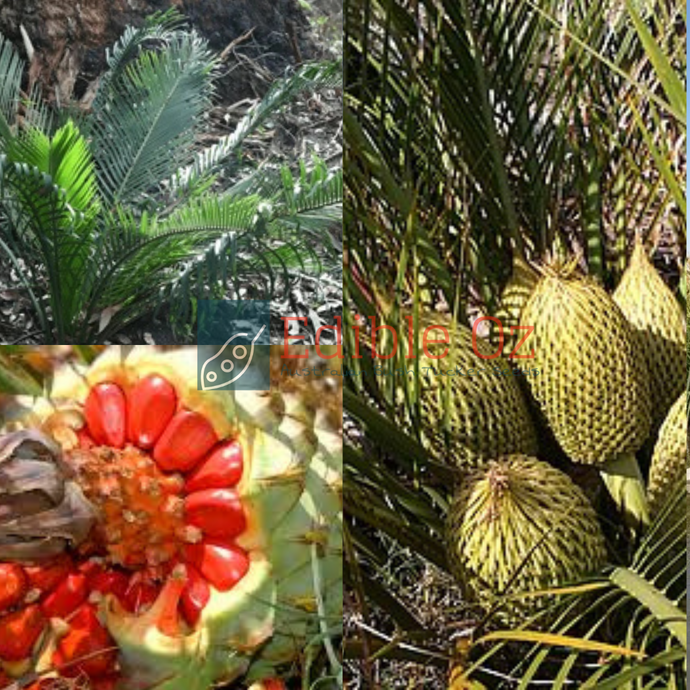
Burrawong / Zamia Palm - Macrozamia riedlei (Djirdji) seeds
Regular price
$7.20
Sale
or make 4 interest-free payments of
$1.80 fortnightly with
 More info
More info
Macrozamia riedlei - Zamia Palm
A living fossil from the jarrah forests of Southwest Australia, prized for its resilience and ancient beauty.
Quick Facts
- Height: 0.5–3.0 meters; typically trunkless but can develop a small trunk.
- Growth Habit: Low-growing, fern-like foliage with a primitive and elegant appearance.
- Soil: Requires well-drained soil; sensitive to fungal attack.
- Water: Highly drought-tolerant once established.
- Climate: Best suited to warm temperate regions; tolerates bushfire conditions.
- Root System: Shallow yet wide, adapted to absorb moisture from a large area.
Why Grow Macrozamia riedlei?
Macrozamia riedlei is not only a stunning addition to gardens but also a living piece of history. This ancient gymnosperm has survived over 200 million years, coexisting with dinosaurs and enduring multiple extinction events. Its graceful, fern-like fronds and fire-resistant trunk make it a striking and hardy specimen plant for Australian gardens, whether as a feature or in large containers.
Cultural and Ecological Significance
- Fire Resistance: Covered in spongy bark, the Zamia Palm can withstand fire, making it well-adapted to Australia’s harsh climate.
- Indigenous Use: Historically, Aboriginal Australians used the seeds as a food source after an extensive detoxification process to remove toxins.
- Ecological Role: Supports local wildlife by providing shelter and habitat in jarrah forests.
Disclaimer: The seeds of Macrozamia riedlei are toxic unless properly processed and should not be consumed without specialised knowledge.
How to Grow
-
Sowing Instructions:
- Soak seeds in water for 24 hours before sowing to enhance germination.
- Plant seeds in well-draining soil, burying them to half their depth with the flat side facing down.
-
Position:
- Prefers a sunny to partially shaded location with protection from waterlogged conditions.
- Suitable for pots, garden beds, or as a feature plant in larger landscapes.
-
Care Tips:
- Water regularly during establishment but reduce frequency once mature.
- Avoid overwatering to prevent fungal infections.
- Mulch around the base to retain moisture and protect roots.
Uses in Your Garden
- Specimen Plant: Adds an ancient and unique focal point to any garden.
- Container Plant: Ideal for large pots on patios or verandas.
- Resilient Landscaping: Thrives in low-maintenance, drought-tolerant gardens.
- Fire-Tolerant Gardens: Excellent for areas prone to bushfires due to its fire-resistant adaptations.
Germination Tips
- Germination can take 12–18 months, requiring patience.
- Maintain consistent soil moisture and warmth during this period.
- Use a well-draining seed-raising mix to prevent fungal issues.
- Place in a protected area with indirect light during germination.
Order Now
Celebrate the resilience and history of Australia’s natural heritage with Macrozamia riedlei. Perfect for gardeners who value both beauty and ancient connections, this plant is sure to captivate.
Order your Zamia Palm seeds today and grow a living piece of the prehistoric world!

Bush Food: Seeds, which are toxic if not prepared correctly.
Various parts of the seeds of Macrozamia species were eaten by indigenous people after treatment, which varied between regions of being by water or be burial. One of the ways was to cook the seed, break it up, and then soak it for up to three weeks in running water.
The Noongar people of the Perth region used the outer coating of the seeds after treating. In some areas of Australia, Aborigines ground the seeds into a flour after special treatments to leach out the toxins.
One reported method includes drying seeds in the sun, then put in a dilly bag and suspended in running water for 4-5 days. They were then crushed and pounded between two flat stones and ground into a fine paste. This paste was wrapped in paper bark, baked under ashes and eaten as cakes.
In Western Australia, only the outer red part was eaten, after treatment by washing and burying. Eaten either raw or roasted, tastes similar to a tomato.
Bush medicine: The plant's medicinal properties are also well known. The Nyungar people use the roots of the Zamia plant to treat headaches, fever, and other ailments. They also use the plant's resin to treat cuts and wounds.
Other uses: Raw seeds were ground into a powder and used to stun fish in local waterways to make the fish easier to catch.
*Toxic to some animals and humans when not pre-treated
